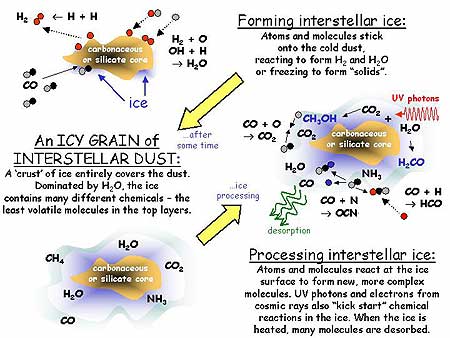It’s a pretty difficult thing to realise that each one of us is just made from the same stuff stars are made of, and even more mind boggling to find out that the regions of space that are rich in molecules just happen to be those same regions where new stars and planets are forming and the possibilities exist for the emergence of new life.
But what is the science behind such claims, and how do we even know there are molecules in space?
Astrochemistry is the study of these molecules in space -
- where are they?
- how did they get there?
- what role they play in controlling or influencing astrophysical processes?
It turns out that of the 140 or so molecules that have been identified to date in interstellar space, many, including the simplest molecules such as H2, H2O, CH3OH and CO2, must be formed at the surfaces of interstellar dust, in reactions involving atoms and molecules that adsorb or ‘freeze-out’ from the gas phase. Although we can use Infrared telescopes to observe the spectra of both the dust grains and their icy mantles, almost nothing is yet understood about the processes involved in the build up of ices in interstellar regions, nor the chemical processes that subsequently lead to the formation of the more complex organic species that are often observed in the gas phase as the ices desorb.
However, with inputs from surface chemistry and physics, as well as the constraints placed on the scenarios by astronomical observations, we have been able to postulate the processes involved in the solid-state chemical evolution of pre-stellar cores and star forming regions (see Fig).

| A schematic representation of the life cycle of an interstellar dust grain in star forming regions. (Image credit: adapted from Fraser et al. Rev. Sci. Inst., 73, 2161 (2002)). |
Interstellar surface chemistry is the focus of Dr. Helen Fraser’s work - and the Astrochemistry Group is the latest addition to the research portfolio of the Department of Physics in Strathclyde. Under controlled pseudo-interstellar conditions in the laboratory, we are starting to understand the surface processes occurring millions of miles away in regions where the newest stars in our galaxy are being born, pulling back a little further the molecular veil that currently obscures our understanding of star and planet formation...and feeding back our knowledge to the astronomy community. It turns out that chemistry, and interstellar molecules in particular, are one of modern astronomy’s best tools for probing the processes of star and planet formation. Through a combination of observational spectroscopy and imaging, theoretical modelling and controlled laboratory studies, we are beginning to unlock the secrets of the cosmic chemical cauldron…